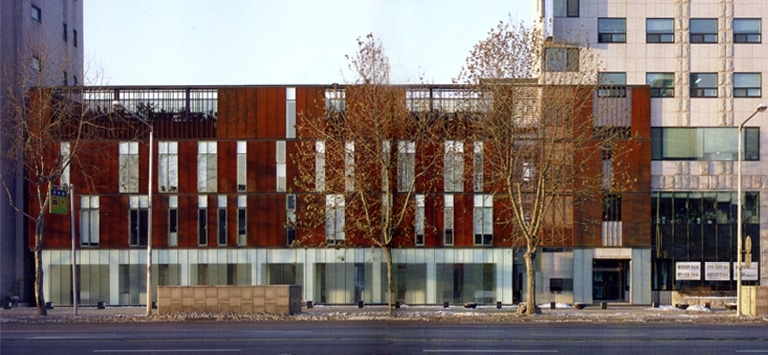Hansol Hospital Renovation
| 완공년도 | 2001 |
| 위치 | 서울 |
| 대지면적 | 918.5㎡ |
| 건축면적 | 509.3㎡ |
| 연면적 | 3,703.2㎡ |
| Structural engineer | 알트 구조 |
| Mechanical engineer | 세아엔지니어링 |
| Electrical engineer | 신원전기 |
| Contractor | 삼협건설 |
| Scale | B4, 7F |
| Lighting design | 뉴라이트 |
| 완공년도 | 2001 |
| 위치 | 서울 |
| 대지면적 | 918.5㎡ |
| 건축면적 | 509.3㎡ |
| 연면적 | 3,703.2㎡ |
| Structural engineer | 알트 구조 |
| Mechanical engineer | 세아엔지니어링 |
| Electrical engineer | 신원전기 |
| Contractor | 삼협건설 |
| Scale | B4, 7F |
| Lighting design | 뉴라이트 |
폭이 50m나 되는 송파대로에 면해 있는 이 병원은 3층 규모의 상가시설을 리노베이션한 것이다. 원래는 이를 허물고, 기존 7층 병원에 붙여서 거의 같은 규모로 증축하기로 한 것이었으나, 설계 도중에 증축 규모를 줄여 나가다가 차라리 기존 건물을 개수하여 쓰는 것이 합리적이라는 판단을 하게 되었고 모자라는 부분은 일부를 옥상에 증축하기로 하였다.
이 건물은 원래 이 지역이 개발될 초창기에 세워진 근린상가 용도여서 전체 용적은 작지만 대지가 허용하는 한 최대의 건폐율로 세워졌고 내부 평면도 최대의 임대면적을 갖기 위해, 계단실을 가운데 두고 각 층을 두 부분으로 분할하고 있었다. 세장한 대지 경계와 법규가 허용하는 건축선에 맞추다 보니 평면형식도 비교적 반듯하여 교정할 필요가 없었던 것도 개수하기로 한 원인이다. 더욱이 기존 7층 병원이 있는 땅과 크기나 모양이 비슷한 까닭에 두 건물을 연결하는 것도 어려운 일이 아니었다.
따라서 이 리노베이션 작업에서는 공간적 의미가 중요한 것이 아니라 송파대로라는 큰 길에 면한 가로의 풍경이 주된 관심이 되었다. 물론 병원이라는 고유의 성격상 각 부분의 공간의 크기를 결정하고 연결하는 일은 대단히 중요하며 병원 건축에 많은 경험이 있더라도 이를 위한 새로운 시간투자는 불가결하다. 그러나 주어진 평면의 틀 안에 이를 배치하는 일은 수학적 계산일 뿐이다. 이러한 한정된 범위에서의 작업의 관심은 내부의 풍경을 어떻게 만드느냐에 있다. 결국 이 프로젝트는 내부나 외부의 풍경에 초점이 맞추어졌다.
50m폭의 대로변에는 플라타너스가 조밀하게 심어져 있어 녹음이 지면 건물의 외형은 1층을 제외하고는 인지되기 어렵다. 따라서 1층 부분과 윗부분은 서로 다른 표정을 갖는 것이 바람직하게 생각되었다. 가볍게 떠있는 블랙박스가 플라타너스 나무들의 배경이 되어 둘 사이의 관계가 수시로 변하는 풍경이 바로 이 건축의 주된 테마가 된다. 겨울철 나뭇잎이 없을 때면 거의 50미터 길이의 블랙박스는 이 거리의 의미심장한 물체가 될 것이다. 주변보다도 낮은 매스이기 떄문에 오히려 큰 긴장을 유발할 것으로 생각하였다.
재료는 요즘 자주 쓰는 코르텐 강이다. 시시각각으로 변하는 이 재료는 플라타너스와 건축과의 관계를 더욱 드라마틱하게 보여줄 것이다.
내부에서의 외부 풍경은 리드미컬한 배열의 창에 의해 순간적으로만 보인다. 이는 프라이버시를 중요시하는 병원이라는 특성 때문이기도 하지만, 이곳의 외부 풍경 자체가 조악한 까닭에 이를 파편화시키지 않으면 안되기 때문이었다. 내부의 재료나 색채, 그리고 가구도 가능한 이런 풍경을 위한 배경으로 간주되도록 중성적 공간으로 만들어졌다.
The hospital, facing the 50-meter-wide Songpa Road, is a refurbishment project of a three-storey commercial facility. Originally, the plan was to demolish it and expand the existing seven-storey hospital to a similar size. However, during the design process, the decision was made to instead utilize the existing building and extend it by constructing additional space on the rooftop.
This building was originally built as a shopping complex in the early stages of development of the area. Despite its small volume, it was built with the maximum area allowed, and the interior floor plan was divided into two parts with a stairwell in the centre to maximize lettable area. The relatively regular floor plan was also due to the linear shape of the land boundary and the building lines allowed by regulations. Additionally, connecting the two buildings was not difficult as the existing seven-storey hospital had a similar size and shape to the new construction.
Therefore, in this refurbishment project, the focus was not on the spatial significance, but rather on the landscape of the horizontal view facing the large, Songpa Road. Of course, determining the size and connecting the spaces of each section was crucial, considering the unique nature of a hospital, and even with experience in hospital architecture, new investments of time are essential. However, arranging them within the given floor plan was merely a mathematical calculation. The interest in this limited scope of work lies in how to create the internal landscape. Ultimately, this project was centred around the internal and external landscape.
The wide road in front is densely planted with plane trees, making it difficult to perceive the building’s appearance except for the first floor. Therefore, it was considered desirable for the first floor and the upper part to have different expressions. The lightweight black box serves as the background for the plane trees, creating a landscape where the relationship between the two constantly changes, becoming the main theme of this architecture. When the leaves are absent in winter, the nearly 50-meter-long black box will become a striking object in distance. As it is a mass lower than the surroundings, it was thought to create a greater tension.
The façade material is corten steel which is commonly used these days. This material, which constantly changes, will further enhance the dramatic relationship between the plane trees and the architecture.
The external landscape from the inside is only visible momentarily through the rhythmic arrangement of windows. This is partly due to the nature of a hospital that values privacy, but also because the external landscape itself is poor. It was important not to fragment it. The interior materials, colours, and even the furniture were designed to be neutral spaces considered as backgrounds for such landscapes as much as possible.







